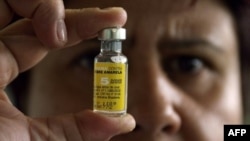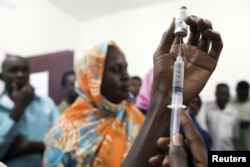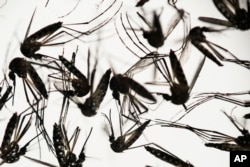The World Health Organization reports that an outbreak of yellow fever in Luanda, the capital of Angola, has now spread to seven other provinces as well as to the Democratic Republic of Congo and Kenya. WHO is calling for a large-scale vaccination campaign to stop the spread of the disease.
The latest official figures find the number of confirmed deaths from yellow fever in Angola now stands at 146, with 885 suspected cases. But, WHO yellow fever expert Sergio Yactayo, who has just returned from a mission in Angola, said these figures are seriously underestimated.
“That is only the point of the iceberg because it means that we can detect only the most severe cases, but there are other cases and you can multiply this number by 10, for example, to have an idea of the part of the problem," Yactayo says.
Most of the deaths and cases are in Luanda, where the outbreak began in early December. Such outbreaks usually occur in tropical rainforests, when monkeys infected by wild mosquitoes pass the virus on to other mosquitoes. The infected mosquitoes then bite humans entering the forest.
The U.N. agency said outbreaks of yellow fever in an urban setting are generally more dangerous and difficult to contain because the disease can spread easily from one person to another. It said a largely unvaccinated population that is bitten by infected mosquitoes can trigger an epidemic.
Vaccination crucial
Vaccination is the most important preventive measure against yellow fever. Yactayo said WHO, its partners and the Angolan ministry of health have undertaken a massive vaccination campaign in Luanda, targeting 6.5 million people. He told VOA this is having positive results.
“In Luanda, this urban severe outbreak will be under control in the following days," he says. "The problem is in the other provinces in Angola and outside of Angola. So, the situation is not under control. There are risks that we need to consider and we need to prevent other things.”
Yactayo said 100 million people in endemic countries in Africa have to be vaccinated to prevent further outbreaks of yellow fever. But, there is a problem. He says only 25 million doses of the vaccine are currently available, and much of the $200 million needed to cover the cost of the vaccines and operational costs is yet to be found.
Mosquitoes to blame
Yellow fever is an acute viral haemorrhagic disease transmitted by infected mosquitoes. The mosquito that transmits the virus is the same one responsible for the Zika virus, dengue fever and Chikungunya.
As with Zika, the yellow fever virus is usually very mild and most people that are infected have little or no symptoms.
However, about 15 percent of patients become severely ill and up to 50 percent will die if they do not get treatment.
In the 1990s, the WHO estimates that 200,000 cases of yellow fever, including 30,000 deaths, occurred globally every year, with 90 percent of the cases in Africa.
But William Perea, the WHO coordinator for control of epidemic diseases, said there has been a significant decrease in the number of cases and deaths since WHO launched the Yellow Fever Initiative 10 years ago.
“Since 2006, we have vaccinated 105 million people. That is a huge amount of people in so few years and that is the main reason we do not have any more outbreaks today in West and Central Africa,” he said.
“We need to do this, however, in the rest of the continent. There are many other countries that are still endemic—middle-level countries. They are in the order of 12 of them and we really need to increase the pace of vaccinations of these countries.”
Countries in West Africa used to have almost monthly outbreaks of the yellow fever virus. A mass vaccination campaign was held in the region two years ago. Since then, the World Health Organization says there has not been a single known case of the disease.












